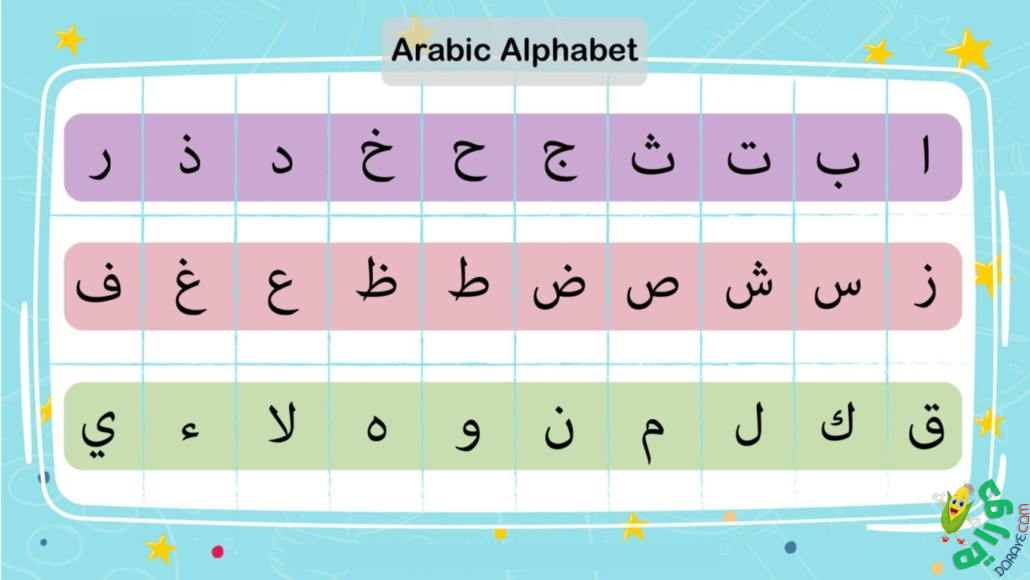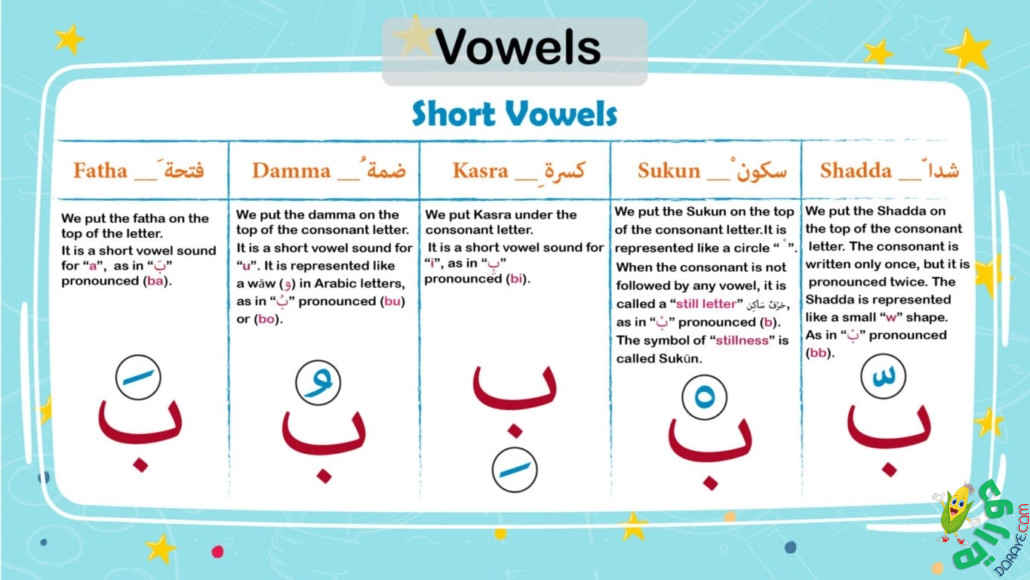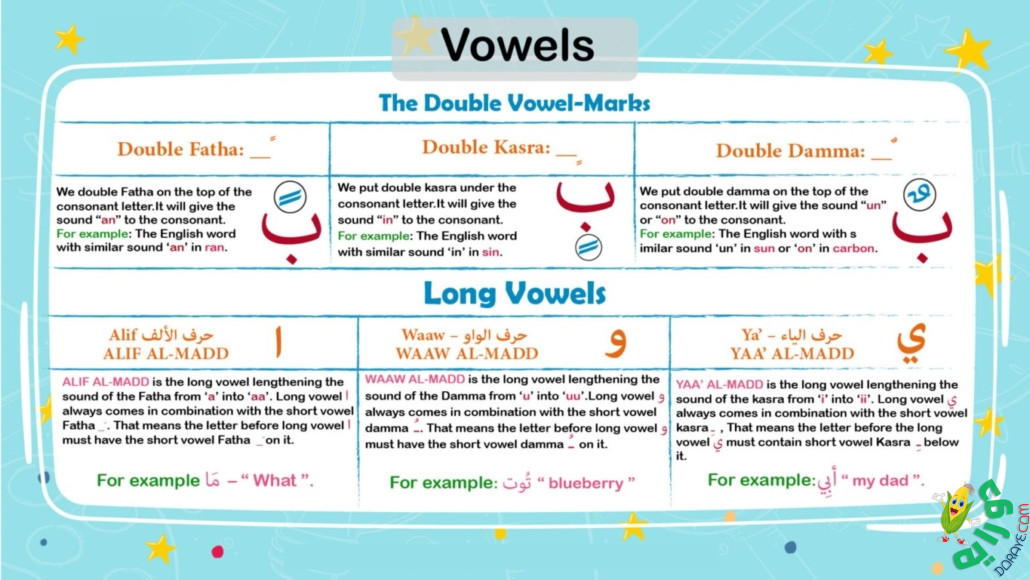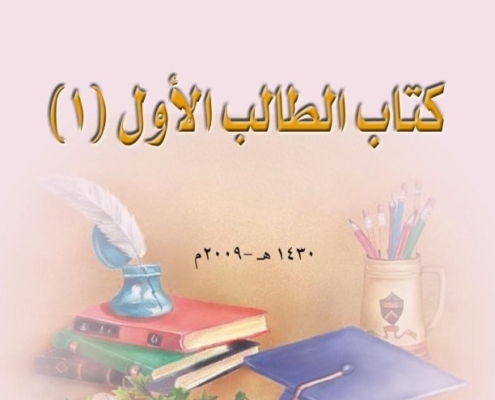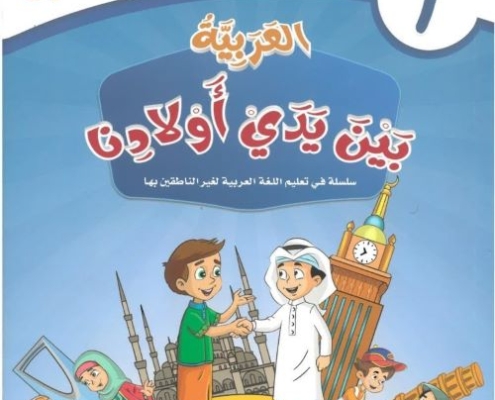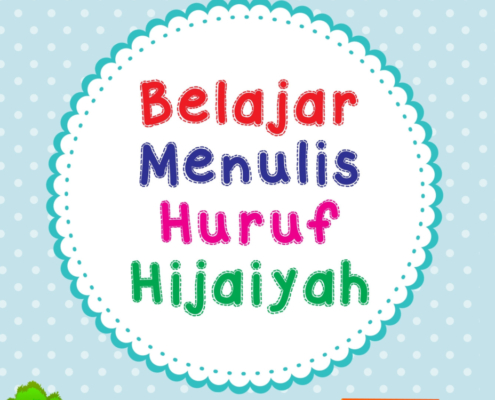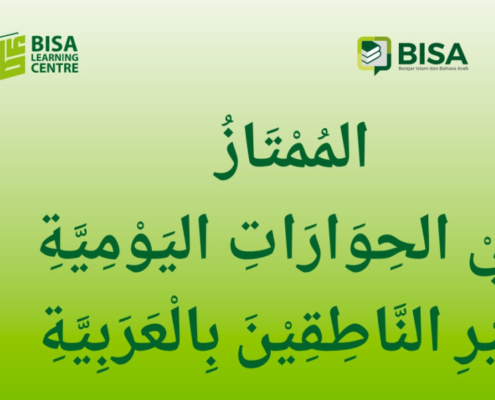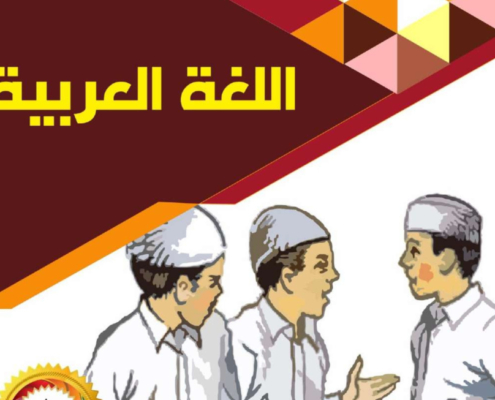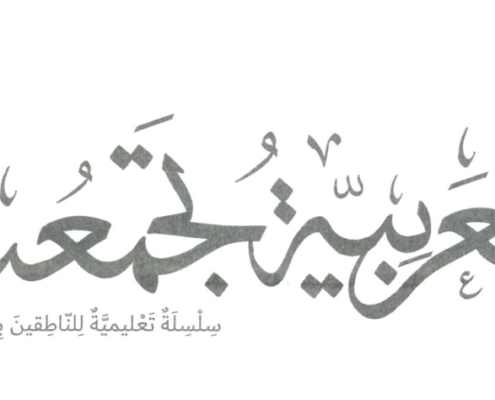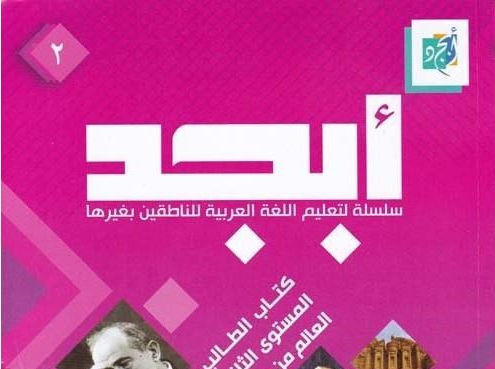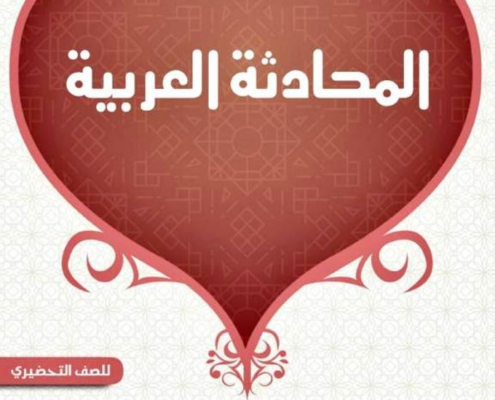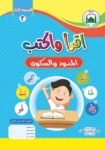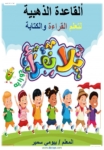Read Arabic for beginners
The 28 Arabic Alphabet
The Aramaic language has fewer consonants than Arabic. During the 7th century, new Arabic letters were created by adding dots to existing letters in order to avoid conflict.
Arabic is written and read from right to left in a cursive style. There is no distinction between uppercase and lowercase letters. However, shapes of letters usually vary depending on whether they are in an initial, medial, or final position in a word.
There are two main collating sequences for the Arabic alphabet: abjad and hija.
The Arabic alphabet is considered an abjad, meaning it only uses consonants, but it is now considered an “impure abjad”.
As with other impure abjads, such as the Hebrew alphabet. Punctuation marks were not adopted until the twentieth century.
In Arabic short vowels are generally not written. Arabic letters change their shape according to their position in a word.
What is letter Hamza (ء)?
Hamza (Arabic: همزة) is a letter in the Arabic alphabet. Hamza is one of the 28 “full” letters. There is only one weak letter in the Arabic Alphabet. The first letter in the Arabic alphabet, Alif, is a weak letter that has two forms, a consonant form and vowel form.
What are the types of written Arabic?
There are two main types of written Arabic:
- Classical Arabic: (CA) is the form of the Arabic language used in literary texts in 7th to 9th centuries. It is the language of the Qur’an, as the Quran was written as early as the 6th century A.D. It differs from Modern Standard Arabic mainly in style and vocabulary.
- Modern Standard Arabic: (اللغة العربية الفصحى / Al-Luġatu L-ʿArabiyyatu L-Fuṣḥā) is the Arabic that is used in everyday life in Arabic speaking countries. Modern Standard Arabic is very similar to Classical Arabic. This kind of language is used by Arabic speakers all around the world.
Arabic is a challenging language to learn. If you’re an English speaker, you’ll need to spend more hours studying Arabic than any other language. It does not mean that Arabic is a hard language to learn but it just needs time from you. Modern Standard Arabic is the best form of Arabic for Arabic language learners to start with. It is the most widely spoken form of Arabic.
The Letters of the Arabic Alphabet are sometimes used for Numbering. The Order Followed is Found in the Following Line:
أَبْجَدْ هَوَّزْ حُطِّي كَلَمُنْ سَعْفُصْ قُرشت ثخذ ضظغ
2- Hijaiyah: الحروف الهجائية
Hijaiyah is a new way. Modern dictionaries and other reference books use Hijaiyah to sort Alphabetical order:
ي | و | ه | ن | م | ل | ك | ق | ف | غ | ع | ظ | ط | ض | ص | ش | س | ز | ر | ذ | د | خ | ح | ج | ث | ت | ب | ا |
y | w | h | n | m | l | k | q | f | gh | ʿ | ẓ | ṭ | ḍ | ṣ | sh | s | z | r | dh | d | kh | ḥ | j | th | t | b | ā |
Arabic Alphabet:
Each Letter has 4 Forms that look sometimes similar to each other:
- When you write the letter in isolated form.
- When you write the letter at the beginning of the word “Initial”.
- When you write the letter in the middle of a word the “Medial”.
- When you write the letter at the end of the word “Final”.
Let’s Learn about ( Letter name, Letter name in Arabic script, Transliteration, Value in Literary Arabic, Closest English equivalent in pronunciation, Contextual forms “Final, Medial, Initial” and Isolated form).
Lettername | Lettername in Arabic script | Transliteration | Value in Literary Arabic | Closest English equivalent in pronunciation | Contextual forms | Isolated form | ||
Final | Medial | Initial | ||||||
ʾalif | أَلِف | ā | various,including /aː/, /æ/ | car, cat“Long a” | ـا | ا | ||
bāʾ | بَاء | b | /b/ | barn | ـب | ـبـ | بـ | ب |
tāʾ | تَاء | t | /t/ | Taiwan | ـت | ـتـ | تـ | ت |
thāʾ | ثَاء | th | /θ/ | think | ـث | ـثـ | ثـ | ث |
jīm | جِيم | j | /d͡ʒ/ | Jam | ـج | ـجـ | جـ | ج |
ḥāʾ | حَاء | ḥħ | /ħ/ | no equivalent | ـح | ـحـ | حـ | ح |
khāʾ | خَاء | kh | /x/ | Scottish loch | ـخ | ـخـ | خـ | خ |
dāl | دَال | d | /d/ | dear | ـد | د | ||
dhāl | ذَال | dh(also ḏ ) | /ð/ | that | ـذ | ذ | ||
rāʾ | رَاء | r | /r/ | rolled r as in perro | ـر | ر | ||
zāy / zayn | زَاي | z | /z/ | zero | ـز | ز | ||
sīn | سِين | s | /s/ | sin | ـس | ـسـ | سـ | س |
shīn | شِين | sh | /ʃ/ | shin | ـش | ـشـ | شـ | ش |
ṣād | صَاد | ṣ | /sˤ/ | Emphatic S“ sauce “ | ـص | ـصـ | صـ | ص |
ḍād | ضَاد | ḍ | /dˤ/ | Emphatic D“ dawn “ | ـض | ـضـ | ضـ | ض |
ṭāʾ | طَاء | ṭ | /tˤ/ | Emphatic T“Taiwan“ | ـط | ـطـ | طـ | ط |
ẓāʾ | ظَاء | ẓ | /ðˤ/ | Emphatic Z“ Zebra “ | ـظ | ـظـ | ظـ | ظ |
ʿayn | عَيْن | ʿ | /ʕ/ | no equivalent | ـع | ـعـ | عـ | ع |
ghayn | غَيْن | gh | /ɣ/ | no equivalent | ـغ | ـغـ | غـ | غ |
fāʾ | فَاء | f | /f/ | far | ـف | ـفـ | فـ | ف |
qāf | قَاف | q | /q/ | no equivalent | ـق | ـقـ | قـ | ق |
kāf | كَاف | k | /k/ | cap | ـك | ـكـ | كـ | ك |
lām | لاَم | l | /l/ | lamp | ـل | ـلـ | لـ | ل |
mīm | مِيم | m | /m/ | me | ـم | ـمـ | مـ | م |
nūn | نُون | n | /n/ | nun | ـن | ـنـ | نـ | ن |
hāʾ | هَاء | h | /h/ | hat | ـه | ـهـ | هـ | ه |
wāw | وَاو | w / ū / | /w/, /uː/ | wet, pool | ـو | و | ||
yāʾ | يَاء | y / ī | /j/, /iː/ | Yoshi, meet | ـي | ـيـ | يـ | ي |
Vowels
An Arabic sentence can have a completely different meaning by a subtle change of the vowels.
There are just six vowels in Arabic. Three short vowels: a, u and i. And three long vowels: aa, ii and uu.
Short Vowels
When a Letter is followed by a short vowel which is also called Haraka (حَرَكَة) in Arabic, which means a “movement”. The short vowels are Fatha, Damma, and Kasra.
Fatha __َ فتحة
ِWe put the fatha on the top of the letter. It is a short vowel sound for “a”, as in “بَ” pronounced (ba).
Damma __ُ ضمة
We put the damma on the top of the consonant letter. It is a short vowel sound for “u”. It is represented like a wāw (و) in Arabic letters, as in “بُ” pronounced (bu) or (bo).
Kasra __ِ كسرة
We put Kasra under the consonant letter. It is a short vowel sound for “i”, as in “بِ” pronounced (bi).
Sukun __ْ سكون
We put the Sukun on the top of the consonant letter. It is represented like a circle “ ْ ”. When the consonant is not followed by any vowel, it is called a “still letter” حَرْفٌ سَاْكِن, as in “بْ” pronounced (b). The symbol of “stillness” is called Sukūn.
Shadda __ّ شدا
We put the Shadda on the top of the consonant letter. The consonant is written only once, but it is pronounced twice. The Shadda is represented by a small “w” shape. As in “بْ” pronounced (bb).
The Double Vowel-Marks
The double vowel-marks signs are an extension of the single vowel marks. The double vowel signs add the ‘-n‘ sound to the single vowel. The “bā” has been used to enable us to see the position of the double vowel sign which is called “tanwīn”.
Double Fatha: __ً
We put double Fatha on the top of the consonant letter. It will give the sound “ an “ to the consonant.
For example: The English word with a similar sound ‘an’ in ran.
Double Damma: __ٌ
We put double damma on the top of the consonant letter. It will give the sound “un” or “on” to the consonant.
For example: The English word with a similar sound ‘un’ in sun or ‘on’ in carbon.
Double Kasra: __ٍ
We put double kasra under the consonant letter. It will give the sound “ in “ to the consonant.
For example: The English word with a similar sound ‘in’ in sin.
Long Vowels
Long vowels lengthen the sounds of short vowels. They produce sounds of double a (aa), double i (ii), and double-u, o (uu) (oo). The three long vowel sounds in Arabic are represented by the following three letters:
- Alif حرف الألف
- Waaw – حرف الواو
- Ya’ – حرف الياء
Sounds of long vowels seem similar to short vowels, but they are stretched longer than short vowels.
We know the short vowels Fatha ـَ, Kasra ـِ, and Damma ـُ. Long vowels came in combination with short vowels. Long vowels have no harakat. Let’s see:
1- Alif حرف الألف ALIF AL-MADD
ALIF AL-MADD is the long vowel lengthening the sound of the Fatha from ‘a’ into ‘aa’. The long vowel ا always comes in combination with the short vowel Fatha _َ. That means the letter before the long vowel ا must have the short vowel Fatha _َ on it.
For example مَا – “ What ”.
2- Waaw – حرف الواو WAAW AL-MADD
WAAW AL-MADD is the long vowel lengthening the sound of the Damma from ‘u’ into ‘uu’.
The long vowel و always comes in combination with the short vowel damma ـُ. That means the letter before the long vowel و must have the short vowel damma ـُ on it.
For example: تُوت “ blueberry ”
3- Ya’ – حرف الياء YAA’ AL-MADD
YAA’ AL-MADD is the long vowel lengthening the sound of the kasra from ‘i’ into ‘ii’. The long vowel ي always comes in combination with the short vowel kasra ـِ , which means the letter before the long vowel ي must contain the short vowel Kasra ـِ below it.
For example أبِي “ my dad ”.
Alif
- There are two types of Alif: the “hamza” and “Alif madd”.
- In Arabic grammar, the “hamza” is the first letter of the alphabet, while “Alif madd” is the long vowel “ ا ”.
- Alif is the first letter in the Arabic alphabet. It has many usages, shapes, and forms.
- Alif is like the shape of a stick or number one 1.
- Alif can be presented as: Initial ا, Medial ـا, Final ـا .
- Alif is one of the three letters Alif ا, Wow و, Ya ي which might be either a consonant or a vowel letter. If Alif comes with Hamza ( ء ) on the top أ or below إ, it is considered as a consonant letter. And if Alif comes without Hamza, it is considered as a vowel letter.
- Alif is a vowel and hamza is a consonant.
- Vowels in Arabic would be the Fatha (a), Damma (u), and Kasra (i).
Consonant Alif always comes at the beginning of a word. But Alif with a Hamza might be seen at the middle or the end of the word so that it is not recognized as an Alif in Arabic, and it is just called Hamza.
The right sound depends on the position of the Hamza (on top – below) or the small marks written (above – below) the letters which are called Diacritics ”Tashkeel”.
Alif with a Fatha: أَ
We put the fatha on the top of the Hamza ءَ. It sounds like A in Apple.
Alif with a Kasra: إِ
We put the Kasra under the Hamza ءِ. It sounds like E in Exercise.
Alif with a Damma: أُ
We put the Damma on the top of the Hamza ءُ. It sounds like O in Opera.
Vowel Alif usually comes in the middle or at the end of a word. It always comes with Sukoon and the letter before it always comes with a Fatha:
Medial Vowel Alif: ( ا ) ( ـا )
It depends on whether the letter before it is connectable or not. It sounds like “a” on Sat.
Final Vowel Alif : ( ا ) ( ى ) ( ـا ) ( ـى )
It depends on whether the letter before it is connectable or not. It sounds like “a” in Cinema. The final vowel Alif might come in a strange form like ( ى ) ( ـى ). This is called Alif Maqsoura or Alif Layyennah.
Initial Vowel Alif: ( آ )
It is the initial Alif with a special mark called Madd mark ( ~ ), it is like the Hamza on the top of Alif. It’s pronounced as two long vowel Alifs in a row.
Kinds of “Hamza”
There are two Kinds of Hamza, Hamzat Aq-qat and Hamzat Al-Wasl:
1- Hamzat aq-qat : همزة القطع
- Written as a hamza over the Alif letter.
- Always the sound of the hamza is written, heard, and pronounced.
Example:
- “ father” ab = أب.
2- Hamzat al-wasl: همزة الوصل
- Written as an ālif without a hamza on it .
- Always the sound of the hamza is heard and pronounced but not written.
Example:
- “Door” bab = باب
Position of the “Hamza”
- The “hamza” comes at the beginning of the word as “ أ, إ, ا ”.
- The “hamza” comes in the middle of the word as “ ـأ, ـئـ, ئـ, ـؤ”.
- The “hamza” comes at the end of the word as “أ, ـأ, ـيء, ـئ, ـؤ, ء”.
Let’s Read some Words Together:
Please read from right to left. Pay careful attention to how letters are joined. Remember letters can have different shapes depending on whether they are in the beginning, middle, or end of a word:
Arabic Word | Translation | Transliteration |
أَكَلَ | Ate | ‘Akala |
أَب | Father | Ab |
بَقَرة | Cow | Baqara |
تُفاح | Apple | Tufah |
ثِمار | Fruits | Thimar |
جَرَس | Bell | Jaras |
حَبل | Robe | Habl |
خِيار | Cucumber | Khiyar |
دَم | Blood | Dam |
ذَهَب | Gold | Zahab |
رَمل | Sand | Raml |
زَمَن | Time | Zaman |
سَلام | Peace | Salam |
شُكرا | Thanks | Shukran |
صُندوق | Box | Sundook |
ضِد | Versus | Dَhid |
طَلَب | Request | Tَalab |
ظَلام | Darkness | Dَ alam |
عَسَل | Honey | Aَ sal |
غُبار | Dust | Ghubar |
فَتح | Unseal | Fath |
قَمَر | Moon | Qamar |
كَلِمة | Word | Kalima |
لَبَن | Milk | Laban |
مَلِك | King | Malik |
نَسر | Eagle | Nasr |
هَرَم | Pyramid | Haram |
تقوى | Piety | Taqwa |
وِلادة | Birth | Wilada |
يَمين | Right | Yameen |
Most Arabic Letters have their Equivalent in the English Alphabet such as:
Y = ى
W = و
N = ن
L = ل
K = ك
F = ف
Some Arabic Letters are so difficult to find their equivalent in the English Alphabet such as:
ع – غ – خ
- We may write “ʿ ” as “ع”.
- We may write “gh” as “غ”.
- We may write “kh” as “خ”.
Tips for learning Arabic
After we have covered the Arabic Alphabet, let’s know some tips for learning:
1- Arabic Reading Practice:
In Arabic, more experienced readers do not require the “harakat” or “diacritical” marks to read the word, by practising it they can read well. So the more you practice the more you will be experienced:
- Make Arabic reading a daily habit.
- Try to practice reading more words every day.
- Always remember that the more you practice, the better your Arabic will be.
2- Arabic Handwriting Practice:
After you have practised reading words and learning phrases and grammar. It is very important to learn how to write Arabic while you are learning the language.
If you want to learn to write Arabic Alphabet, you should practice handwriting well:
- Write the isolated, initial, medial and final form variations.
- Start by tracing the letters, it helps you to quickly memorize letters and to be able to write them with punctuation.
Writing Arabic naturally forces you to become familiar with the shapes of the letters. And that will improve your ability to understand the Arabic alphabet much quicker.
Numbers in the Arabic Alphabet
Numbers are probably one of the easiest words to incorporate into your day. We can’t live without counting. Let’s learn them together:
Number | Number in Arabic Alphabet | Transliteration |
١ | وَاحِد | Wahid |
٢ | اِثْنَان | Ithnan |
٣ | ثَلَاثَة | Thalaathah |
٤ | أَرْبَعَة | Arbaʿa |
٥ | خَمْسَة | Khamsa |
٦ | سِتَّة | Sitta |
٧ | سَبْعَة | Sabʿa |
٨ | ثَمَانِيَة | Thamaniya |
٩ | تِسْعَة | Tisʿa |
١٠ | عَشَرَة | Ashar |
١١ | أَحَدَ عَشَرَ | Ahada Ashar |
١٢ | اِثْنَا عَشَرَ | Ithna Ashar |
١٣ | ثَلَاثَةَ عَشَرَ | Thalatha Ashar |
١٤ | أَرْبَعَةَ عَشَرَ | Arbaʿa Ashar |
١٥ | خَمْسَةَ عَشَرَ | Khamsa Ashar |
١٦ | سِتَّةَ عَشَرَ | Sitta Ashar |
١٧ | سَبْعَةَ عَشَرَ | Sabʿa Ashar |
١٨ | ثَمَانِيَةَ عَشَرَ | Thamaniya Ashar |
١٩ | تِسْعَةَ عَشَرَ | Tisʿa Ashar |
٢٠ | عِشْرُونَ | Ashrun |
٢١ | وَاحِد و عِشْرُونَ | Wahid wa Ishrun |
٢٢ | اِثْنَان و عِشْرُونَ | Ithnan wa Ishrun |
٢٣ | ثَلَاثَة و عِشْرُونَ | Thalathah wa Ishrun |
٢٤ | أَرْبَعَة و عِشْرُونَ | Arbaʿa wa Ishrun |
٢٥ | خَمْسَة و عِشْرُونَ | Khamsa wa Ishrun |
٢٦ | سِتَّة و عِشْرُونَ | Sitta wa Ishrun |
٢٧ | سَبْعَة و عِشْرُونَ | Sabʿa wa Ishrun |
٢٨ | ثَمَانِيَة و عِشْرُونَ | Thamaniya wa Ishrun |
٢٩ | تِسْعَة و عِشْرُونَ | Tisʿa wa Ishrun |
٣٠ | ثَلَاثُونَ | Thalathun |
٣١ | وَاحِد و ثَلَاثُونَ | Wahid wa Thalathun |
٣٢ | اِثْنَان و ثَلَاثُونَ | Thnan wa Thalathun |
٣٣ | ثَلَاثَة و ثَلَاثُونَ | Thalaathah wa Thalathun |
٣٤ | أَرْبَعَة و ثَلَاثُونَ | Arbaʿa wa Thalathun |
٣٥ | خَمْسَة و ثَلَاثُونَ | Khamsa wa Thalathun |
٣٦ | سِتَّة و ثَلَاثُونَ | Sitta wa Thalathun |
٣٧ | سَبْعَة و ثَلَاثُونَ | Sabʿa wa Thalathun |
٣٨ | ثَمَانِيَة و ثَلَاثُونَ | Thamaniya wa Thalathun |
٣٩ | تِسْعَة و ثَلَاثُونَ | Tisʿa wa Thalathun |
٤٠ | أَرْبَعُونَ | Arbaʿun |
٤١ | وَاحِد و أَرْبَعُونَ | Wahid wa Arbaʿun |
٤٢ | اِثْنَان و أَرْبَعُونَ | Ithnan wa Arbaʿun |
٤٣ | ثَلَاثَة و أَرْبَعُونَ | Thalaathah wa Arbaʿun |
٤٤ | أَرْبَعَة و أَرْبَعُونَ | Arbaʿa wa Arbaʿun |
٤٥ | خَمْسَة و أَرْبَعُونَ | Khamsa wa Arbaʿun |
٤٦ | سِتَّة و أَرْبَعُونَ | Sitta wa Arbaʿun |
٤٧ | سَبْعَة و أَرْبَعُونَ | Sabʿa wa Arbaʿun |
٤٨ | ثَمَانِيَة و أَرْبَعُونَ | Thamaniya wa Arbaʿun |
٤٩ | تِسْعَة و أَرْبَعُونَ | Tisʿa wa Arbaʿun |
٥٠ | خَمْسُونَ | Khamsun |
٥١ | وَاحِد و خَمْسُونَ | Wahid wa Khamsun |
٥٢ | اِثْنَان و خَمْسُونَ | Ithnan wa Khamsun |
٥٣ | ثَلَاثَة و خَمْسُونَ | Thalathah wa Khamsun |
٥٤ | أَرْبَعَة و خَمْسُونَ | Arbaʿa wa Khamsun |
٥٥ | خَمْسَة و خَمْسُونَ | Khamsa wa Khamsun |
٥٦ | سِتَّة و خَمْسُونَ | Sitta wa Khamsun |
٥٧ | سَبْعَة و خَمْسُونَ | Sabʿa wa Khamsun |
٥٨ | ثَمَانِيَة و خَمْسُونَ | Thamaniya wa Khamsun |
٥٩ | تِسْعَة و خَمْسُونَ | tisʿa wa Khamsun |
٦٠ | سِتُّونَ | Sittun |
٦١ | وَاحِد و سِتُّونَ | Wahid wa Sittun |
٦٢ | اِثْنَان و سِتُّونَ | Ithnan wa Sittun |
٦٣ | ثَلَاثَة و سِتُّونَ | Thalaathah wa Sittun |
٦٤ | أَرْبَعَة و سِتُّونَ | Arbaʿa wa Sittun |
٦٥ | خَمْسَة و سِتُّونَ | Khamsa wa Sittun |
٦٦ | سِتَّة و سِتُّونَ | Sitta wa Sittun |
٦٧ | سَبْعَة و سِتُّونَ | Sabʿa wa Sittun |
٦٨ | ثَمَانِيَة و سِتُّونَ | Thamaniya wa Sittun |
٦٩ | تِسْعَة و سِتُّونَ | tisʿa wa sittun |
٧٠ | سَبْعُونَ | Sab’un |
٧١ | وَاحِد و سَبْعُونَ | Wahid wa Sabun |
٧٢ | اِثْنَان و سَبْعُونَ | Ithnan wa Sabun |
٧٣ | ثَلَاثَة و سَبْعُونَ | Thalaathah wa Sabun |
٧٤ | أَرْبَعَة و سَبْعُونَ | Arbaʿa wa Sabun |
٧٥ | خَمْسَة و سَبْعُونَ | Khamsa wa Sabun |
٧٦ | سِتَّة و سَبْعُونَ | Sitta wa Sabun |
٧٧ | سَبْعَة و سَبْعُونَ | Sabʿa wa Sabun |
٧٨ | ثَمَانِيَة و سَبْعُونَ | Thamaniya wa Sabun |
٧٩ | تِسْعَة و سَبْعُونَ | Tisʿa wa Sabun |
٨٠ | ثَمَانُونَ | Thamanun |
٨١ | وَاحِد و ثَمَانُونَ | Wahid wa Thamanun |
٨٢ | اِثْنَان و ثَمَانُونَ | Ithnan wa Thamani |
٨٣ | ثَلَاثَة و ثَمَانُونَ | Thalaathah wa Thamanun |
٨٤ | أَرْبَعَة و ثَمَانُونَ | Arbaʿa wa Thamanun |
٨٥ | خَمْسَة و ثَمَانُونَ | Khamsa wa Thamanun |
٨٦ | سِتَّة و ثَمَانُونَ | Sitta wa Thamanun |
٨٧ | سَبْعَة و ثَمَانُونَ | Sabʿa wa Thamanun |
٨٨ | ثَمَانِيَة و ثَمَانُونَ | Thamaniya wa Thamani |
٨٩ | تِسْعَة و ثَمَانُونَ | Tisʿa wa Thamanun |
٩٠ | تِسْعُونَ | Ti’un |
٩١ | وَاحِد و تِسْعُونَ | Wahid wa Tis’un |
٩٢ | اِثْنَان و تِسْعُونَ | Ithnan wa Tis’un |
٩٣ | ثَلَاثَة و تِسْعُونَ | Thalaathah wa Tis’un |
٩٤ | أَرْبَعَة و تِسْعُونَ | Arbaʿa wa Tis’un |
٩٥ | خَمْسَة و تِسْعُونَ | Khamsa wa Tis’un |
٩٦ | سِتَّة و تِسْعُونَ | Sitta wa Tis’un |
٩٧ | سَبْعَة و تِسْعُونَ | Sabʿa wa Tis’un |
٩٨ | ثَمَانِيَة و تِسْعُونَ | Thamaniya wa Tis’un |
٩٩ | تِسْعَة و تِسْعُونَ | Tisʿa wa Tis’un |
١٠٠ | مِئَة | Mi’a |

